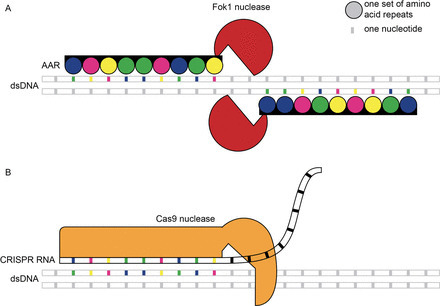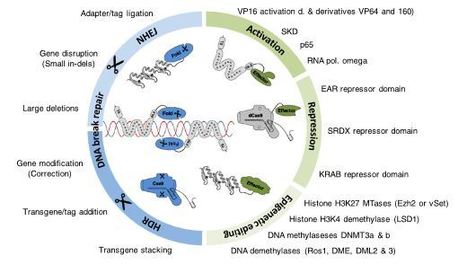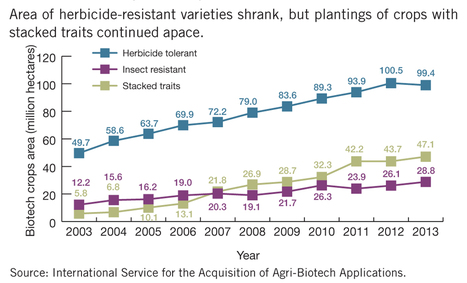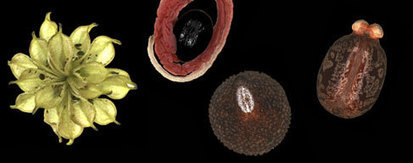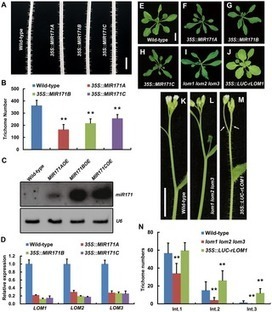 Your new post is loading...
 Your new post is loading...

|
Scooped by
Loïc Lepiniec
April 21, 2014 5:21 AM
|
Synthetic biology is an emerging field uniting scientists from all disciplines with the aim of designing or re-designing biological processes. Initially, synthetic biology breakthroughs came from microbiology, chemistry, physics, computer science, materials science, mathematics, and engineering disciplines. A transition to multicellular systems is the next logical step for synthetic biologists and plants will provide an ideal platform for this new phase of research. This meeting report highlights some of the exciting plant synthetic biology projects, and tools and resources, presented and discussed at the 2013 GARNet workshop on plant synthetic biology.
Via Christophe Jacquet

|
Scooped by
Loïc Lepiniec
April 21, 2014 4:33 AM
|
In flowering plants, meiocytes develop from subepidermal cells in anthers and ovules. The mechanisms that integrate gene-regulatory processes with meiotic programs during reproductive development remain poorly characterized. Here, we show that Arabidopsis thaliana plants deficient in ACTIN-RELATED PROTEIN6 (ARP6), a subunit of the SWR1 ATP-dependent chromatin-remodeling complex, exhibit defects in prophase I of female meiosis. We found that this meiotic defect is likely due to dysregulated expression of meiotic genes, particularly those involved in meiotic recombination, including DMC1 (DISRUPTED MEIOTIC cDNA1). Analysis of DMC1 expression in arp6 mutant plants indicated that ARP6 inhibits expression of DMC1 in the megasporocyte and surrounding nonsporogeneous ovule cells before meiosis. After cells enter meiosis, however, ARP6 activatesDMC1 expression specifically in the megasporocyte even as it continues to inhibitDMC1 expression in the nonsporogenous ovule cells. We further show that deposition of the histone variant H2A.Z, mediated by the SWR1 chromatin-remodeling complex at the DMC1 gene body, requires ARP6. Therefore, ARP6 regulates female meiosis by determining the spatial and temporal patterns of gene expression required for proper meiosis during ovule development.
L'Assemblée nationale a adopté une proposition de loi socialiste qui prévoit d'interdire la culture du maïs transgénique en France.
Via Pôle Veille AgroParisTech

|
Scooped by
Loïc Lepiniec
April 18, 2014 7:16 AM
|
When we think about threats to the environment, we tend to picture cars and smokestacks, not dinner. But the truth is, our need for food poses one of the biggest dangers to the planet.

|
Rescooped by
Loïc Lepiniec
from TAL effector science
April 18, 2014 3:43 AM
|
(via T. Schreiber, thx) Fichtner et al, 2014 Recently, the use of programmable DNA-binding proteins such as ZFP/ZFNs, TALE/TALENs and CRISPR/Cas has produced unprecedented advances in gene targeting and genome editing in prokaryotes and eukaryotes. These advances allow researchers to specifically alter genes, reprogram epigenetic marks, generate site-specific deletions and potentially cure diseases. Unlike previous methods, these precision genetic modification techniques (PGMs) are specific, efficient, easy to use and economical. Here we discuss the capabilities and pitfalls of PGMs and highlight the recent, exciting applications of PGMs in molecular biology and crop genetic engineering. Further improvement of the efficiency and precision of PGM techniques will enable researchers to precisely alter gene expression and biological/chemical pathways, probe gene function, modify epigenetic marks and improve crops by increasing yield, quality and tolerance to limiting biotic and abiotic stress conditions.
Via dromius

|
Scooped by
Loïc Lepiniec
April 13, 2014 3:29 PM
|
Eukaryotic plasma membranes are highly compartmentalized structures. So far, only a few individual proteins that function in a wide range of cellular processes have been shown to segregate into microdomains. However, the biological roles of most microdomain-associated proteins are unknown. Here, we investigated the heterogeneity of distinct microdomains and the complexity of their coexistence. This diversity was determined in living cells of intact multicellular tissues using 20 different marker proteins from Arabidopsis thaliana, mostly belonging to the Remorin protein family. These proteins associate with microdomains at the cytosolic leaflet of the plasma membrane. We characterized these membrane domains and determined their lateral dynamics by extensive quantitative image analysis. Systematic colocalization experiments with an extended subset of marker proteins tested in 45 different combinations revealed the coexistence of highly distinct membrane domains on individual cell surfaces. These data provide valuable tools to study the lateral segregation of membrane proteins and their biological functions in living plant cells. They also demonstrate that widely used biochemical approaches such as detergent-resistant membranes cannot resolve this biological complexity of membrane compartmentalization in vivo.

|
Rescooped by
Loïc Lepiniec
from Plants and Microbes
April 9, 2014 2:34 AM
|
Many parasites commandeer the bodies of their hosts in order to spread. Examples of this include horsehair worms that reach water by forcing their cricket hosts to drown themselves, and liver flukes that drive infected ants to climb blades of grass, where cows can eat the insects, and so the flukes. But parasites can turn plants into zombies, too — and a team of scientists from the John Innes Centre in Norwich, UK, has now discovered how they do it. When plants are infected by parasitic bacteria called phytoplasmas, their flowers turn into leafy shoots, their petals turn green and they develop a mass of shoots called ‘witches’ brooms’. This transformation sterilizes the plant, while attracting the sap-sucking insects that carry the bacteria to new hosts. “The plant appears alive, but it’s only there for the good of the pathogen,” says plant pathologist Saskia Hogenhout from the John Innes Centre in Norwich, UK. “In an evolutionary sense, the plant is dead and will not produce offspring.” “Many might baulk at the concept of a zombie plant because the idea of plants behaving is strange,” says David Hughes, a parasitologist at Pennsylvania State University in University Park. “But they do, and since they do, why wouldn't parasites have evolved to take over their behaviour, as they do for ants and crickets?”
Via Kamoun Lab @ TSL

|
Rescooped by
Loïc Lepiniec
from Panorama de presse
April 4, 2014 4:48 AM
|
Le PDG du conseil d’administration de l’établissement public concède que la marque Paris-Saclay n’est pas encore installée, et regrette d’inutiles guéguerres. Les avancées sont néanmoins réelles , les délais seront tenus, Métropole du Grand Paris ou non
Via École polytechnique

|
Scooped by
Loïc Lepiniec
April 4, 2014 2:01 AM
|
Master De 150 masters à 48 masters mutualisés : un résultat tangible d’un travail énorme, collectif et représentatif de l’esprit de l’Université Paris-Saclay Depuis un...
Via Univ Paris-Saclay

|
Scooped by
Loïc Lepiniec
March 28, 2014 6:20 PM
|

|
Scooped by
Loïc Lepiniec
March 28, 2014 3:04 AM
|
|

|
Scooped by
Loïc Lepiniec
April 21, 2014 4:54 AM
|

|
Scooped by
Loïc Lepiniec
April 21, 2014 4:35 AM
|
175.2 million hectares of biotech crops were grown globally in 2013. In the United States, the first commercialized drought-tolerant maize (MON87460) expressing Bacillus subtilis cold shock protein B (cspB) was planted by 2,000 farmers over 50,000 hectares. Indonesia also approved drought-tolerant sugarcane expressing choline dehydrogenase (betA), which accumulates membrane-protectant glycine betaine. Other drought-resistant varieties of sugarcane, maize, wheat and rice are also in field trials in Argentina, Brazil, India, Egypt, South Africa, Kenya and Uganda. Brazil continues to lead the world in annual growth (10%) of transgenic acreage.
Thirty years after the production of the first generation of genetically modified plants we are now set to move into a new era of recombinant crop technology through the application of synthetic biology to engineer new and complex input and output traits. The use of synthetic biology technologies will represent more than incremental additions of transgenes, but rather the directed design of completely new metabolic pathways, physiological traits, and developmental control strategies. The need to enhance our ability to improve crops through new engineering capability is now increasingly pressing as we turn to plants not just for food, but as a source of renewable feedstocks for industry. These accelerating and diversifying demands for new output traits coincide with a need to reduce inputs and improve agricultural sustainability. Faced with such challenges, existing technologies will need to be supplemented with new and far-more-directed approaches to turn valuable resources more efficiently into usable agricultural products. While these objectives are challenging enough, the use of synthetic biology in crop improvement will face public acceptance issues as a legacy of genetically modified technologies in many countries. Here we review some of the potential benefits of adopting synthetic biology approaches in improving plant input and output traits for their use as industrial chemical feedstocks, as linked to the rapidly developing biorefining industry. Several promising technologies and biotechnological targets are identified along with some of the key regulatory and societal challenges in the safe and acceptable introduction of such technology.
Via Christophe Jacquet

|
Scooped by
Loïc Lepiniec
April 21, 2014 4:23 AM
|
ISSS_2015_FLYER The ISSS workshop on Seed Longevity will be organised in Gatersleben (Germany) from 7-10 July 2015.

|
Rescooped by
Loïc Lepiniec
from Ag Biotech News
April 18, 2014 3:43 AM
|
Genetically-modified food which boosts health could be on British dining tables by the end of the decade after the Government gave the green light for the first field trial of nutrient enriched crops. The Department for Environment, Food and Rural Affairs today granted permission for Rothamsted Research to grow plants enhanced with the same omega-3 fatty acids found in fish oil, in a decision branded a 'milestone' by scientists... If successful the plant oil will be fed to fish, such as farmed salmon, to boost their uptake, but it could eventually be used in oils and spreads such as margarine. Professor Johnathan Napier, lead scientist of this project at Rothamsted Research, said: “Omega-3 doesn’t occur in any other plant species but there is a real pressing need for it for health reasons. “The way that fish currently acquire their omega-3, from algae, is not sustainable. So we are trying to find another source... This is something that could reduce our dependency on fish or supplements in the long term.” Omega-3 fatty acids have been widely linked to health benefits, such as lowering the risk of heart disease, cancers and neuro-degenerative diseases. Although omega-3 is often described as fish oil, it is in fact made by microscopic marine algae that are eaten or absorbed by fish. Farmed fish grown in cages are unable to absorb sufficient omega-3 in their diets so they have to be fed on smaller fish which critics claim is unsustainable. The Rothamsted Research scientists have copied and synthesised the genes from the algae and then spliced them into a plant called ‘Camelina sativa’, known as “false flax”, which is widely grown for its seed oil. Although the main aim of the research is to produce GM crops that could be made into food for farmed fish, the seeds could eventually be used in other foods, such as margarine. It is the first crop to be given permission since a wide-ranging report, commissioned by the government, gave the green light to GM in March... GM crops are already widely used in the US, Canada, Brazil, Argentina and India. Around 85 per cent of all corn crops in the US are now GM. Sir Mark has warned that Britain risks falling behind if it does not begin GM production soon. Professor Cathie Martin, the John Innes Centre, which has been producing enhanced tomatoes in green houses said: "Modern diets contain low levels of omega-3 polyunsaturated fatty acids. Diets with high omega-3 are strongly associated with health and protection from a range of chronic diseases including cardiovascular diseases. Cultivation of crops that produce oils high in omega 3 offers a sustainable supply of these health beneficial products for the first time.” ... http://www.telegraph.co.uk/science/science-news/10769797/GM-crops-given-green-light-by-government.html
Via Alexander J. Stein
Based primarily on the 2012 NIH Workforce report this infographic represents current workforce sizes and annual fluxes before and after a PhD in the b...
Via Mary Williams

|
Scooped by
Loïc Lepiniec
April 11, 2014 3:17 AM
|
The miR156-targeted SQUAMOSA PROMOTER BINDING PROTEIN LIKE (SPL) transcription factors function as an endogenous age cue in regulating plant phase transition and phase-dependent morphogenesis, but the control of SPL output remains poorly understood. InArabidopsis thaliana the spatial pattern of trichome is a hallmark of phase transition and governed by SPLs. Here, by dissecting the regulatory network controlling trichome formation on stem, we show that the miR171-targeted LOST MERISTEMS 1 (LOM1), LOM2 and LOM3, encoding GRAS family members previously known to maintain meristem cell polarity, are involved in regulating the SPL activity. Reduced LOM abundance by overexpression of miR171 led to decreased trichome density on stems and floral organs, and conversely, constitutive expression of the miR171-resistant LOM (rLOM) genes promoted trichome production, indicating that LOMs enhance trichome initiation at reproductive stage. Genetic analysis demonstrated LOMs shaping trichome distribution is dependent on SPLs, which positively regulate trichome repressor genes TRICHOMELESS 1 (TCL1) and TRIPTYCHON (TRY). Physical interaction between the N-terminus of LOMs and SPLs underpins the repression of SPL activity. Importantly, other growth and developmental events, such as flowering, are also modulated by LOM-SPL interaction, indicating a broad effect of the LOM-SPL interplay. Furthermore, we provide evidence that MIR171 gene expression is regulated by its targeted LOMs, forming a homeostatic feedback loop. Our data uncover an antagonistic interplay between the two timing miRNAs in controlling plant growth, phase transition and morphogenesis through direct interaction of their targets.
Via Mary Williams

|
Rescooped by
Loïc Lepiniec
from Le Fil @gricole
April 4, 2014 3:26 AM
|
Et si l'avenir de l'agriculture s'écrivait dans le marc de raisin ? Pascale Goupil est Lozérienne. Cette chercheuse en biologie moléculaire à l'université de Clermont-Ferrand a fait, avec son équipe, des découvertes fondamentales qui pourraient bien transformer l'agriculture de demain… explication
Via les documentalistes des Chambres d'agriculture

|
Scooped by
Loïc Lepiniec
April 1, 2014 2:12 AM
|

|
Scooped by
Loïc Lepiniec
March 29, 2014 2:37 AM
|
PLOS ONE: an inclusive, peer-reviewed, open-access resource from the PUBLIC LIBRARY OF SCIENCE. Reports of well-performed scientific studies from all disciplines freely available to the whole world.

|
Scooped by
Loïc Lepiniec
March 28, 2014 3:13 AM
|
The unfolded protein response (UPR) is activated to sustain cell survival by reducing misfolded protein accumulation in the endoplasmic reticulum (ER). The UPR also promotes programmed cell death (PCD) when the ER stress is severe; however, the underlying molecular mechanisms are less understood, especially in plants. Previously, two membrane-associated transcriptions factors (MTFs), bZIP28 and bZIP60, were identified as the key regulators for cell survival in the plant ER stress response. Here, we report the identification of another MTF, NAC089, as an important PCD regulator in Arabidopsis (Arabidopsis thaliana) plants. NAC089 relocates from the ER membrane to the nucleus under ER stress conditions. Inducible expression of a truncated form of NAC089, in which the transmembrane domain is deleted, induces PCD with increased caspase 3/7-like activity and DNA fragmentation. Knock-downNAC089 in Arabidopsis confers ER stress tolerance and impairs ER-stress-induced caspase-like activity. Transcriptional regulation analysis and ChIP-qPCR reveal that NAC089 plays important role in regulating downstream genes involved in PCD, such as NAC094, MC5 andBAG6. Furthermore, NAC089 is up-regulated by ER stress, which is directly controlled by bZIP28 and bZIP60. These results show that nuclear relocation of NAC089 promotes ER-stress-induced PCD, and both pro-survival and pro-death signals are elicited by bZIP28 and bZIP60 during plant ER stress response.
|
 Your new post is loading...
Your new post is loading...
 Your new post is loading...
Your new post is loading...







